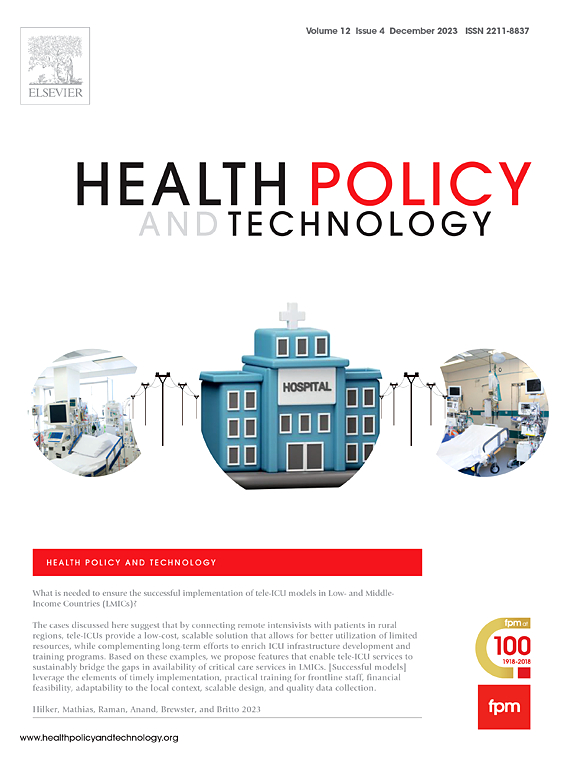中国的价格谈判是否为国民医保受益人带来了高价值新药?
IF 3.7
3区 医学
Q1 HEALTH POLICY & SERVICES
引用次数: 0
摘要
目的2017年起,中国启动药品价格谈判,将在研药品纳入基本医疗保险报销目录。从2020年起,年度价格谈判将接受制药公司主动提出的申请。然而,谈判是否会吸引具有更高临床效益的新药来提高BMI的分配效率,目前尚不清楚。方法收集2015年1月1日至2023年6月30日在中国获批的肿瘤新适应症,并核对其最近4次谈判(2020-2023年)的报销情况。临床获益被定义为在支持适应症批准的关键试验中对主要结局的治疗效果。结果分为反应率、事件发生时间和总生存期。建立了工具变量(IV)策略,以探索每种结果类型的报销状况与临床获益程度之间的关系。结果共收集到222个肿瘤适应症,其中60.4%的患者通过价格谈判获得了报销资格。IV回归发现,报销适应症的反应率比未报销适应症高20%,发生特定事件的风险比低0.26;但两组之间的生存效益并没有差异。结论中国的价格谈判为BMI带来了替代效益更高的新药,但并没有吸引到生存效益更高的新药。需要进行监管创新,在报销决策过程中优先考虑验证治疗价值的药物,以改善药物可及性。本文章由计算机程序翻译,如有差异,请以英文原文为准。
Does price negotiation in China bring high-value novel drugs to the national medical insurance beneficiaries?
Objective
China has initiated the drug price negotiation since 2017 to incorporate in-patent drugs into the reimbursement list of the Basic Medical Insurance (BMI). From 2020 onwards, the annual price negotiation accepts unsolicited applications from drug companies. However, it's unknown whether the negotiations attract new drugs with higher clinical benefits to improve the allocative efficiency of the BMI.
Method
We collected the new oncology indications approved in China between Jan 1, 2015 and June 30, 2023, and checked their reimbursement status in the recent four negotiations (2020–2023). The clinical benefits were defined as the treatment effects on the primary outcome in the pivotal trial supporting the indication approval. The outcomes were classified as response rate, time-to-event, and overall survival. An instrument variables (IV) strategy was established to explore the association between the reimbursement status and the magnitude of clinical benefits for each outcome type.
Results
A total of 222 oncology indications were gathered, among which 60.4 % obtained the reimbursement eligibility through the price negotiations. The IV regressions found that, the reimbursed indications had a 20 % higher response rate and a 0.26 lower hazard ratio of incurring a specific event than the non-reimbursed; but the survival benefits didn't differ between the two groups.
Conclusion
The price negotiations in China have brought new drugs with higher surrogate benefits into the BMI, yet have not attracted those with superior survival benefits. Regulatory innovations are needed to prioritize drugs validating therapeutic value in the reimbursement decision-making process to refine drug access.
求助全文
通过发布文献求助,成功后即可免费获取论文全文。
去求助
来源期刊

Health Policy and Technology
Medicine-Health Policy
CiteScore
9.20
自引率
3.30%
发文量
78
审稿时长
88 days
期刊介绍:
Health Policy and Technology (HPT), is the official journal of the Fellowship of Postgraduate Medicine (FPM), a cross-disciplinary journal, which focuses on past, present and future health policy and the role of technology in clinical and non-clinical national and international health environments.
HPT provides a further excellent way for the FPM to continue to make important national and international contributions to development of policy and practice within medicine and related disciplines. The aim of HPT is to publish relevant, timely and accessible articles and commentaries to support policy-makers, health professionals, health technology providers, patient groups and academia interested in health policy and technology.
Topics covered by HPT will include:
- Health technology, including drug discovery, diagnostics, medicines, devices, therapeutic delivery and eHealth systems
- Cross-national comparisons on health policy using evidence-based approaches
- National studies on health policy to determine the outcomes of technology-driven initiatives
- Cross-border eHealth including health tourism
- The digital divide in mobility, access and affordability of healthcare
- Health technology assessment (HTA) methods and tools for evaluating the effectiveness of clinical and non-clinical health technologies
- Health and eHealth indicators and benchmarks (measure/metrics) for understanding the adoption and diffusion of health technologies
- Health and eHealth models and frameworks to support policy-makers and other stakeholders in decision-making
- Stakeholder engagement with health technologies (clinical and patient/citizen buy-in)
- Regulation and health economics
 求助内容:
求助内容: 应助结果提醒方式:
应助结果提醒方式:


